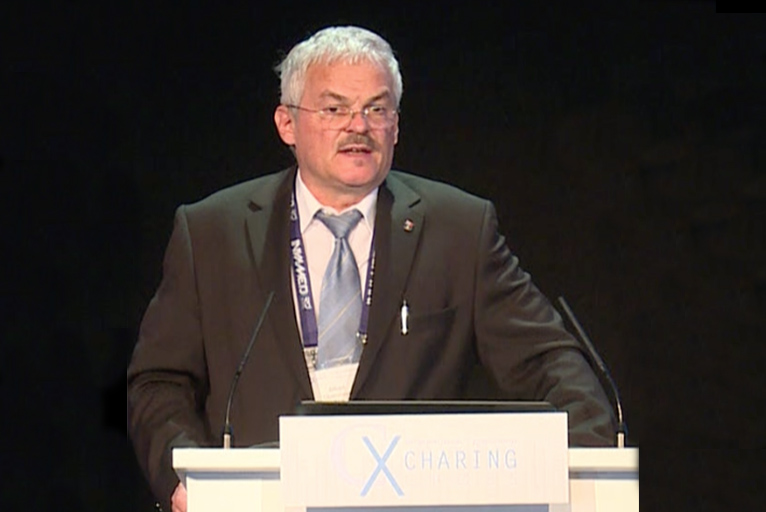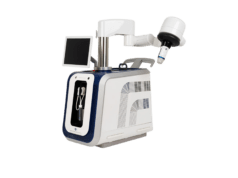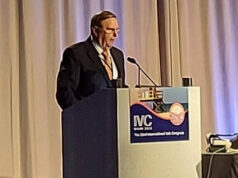
A new treatment modality is aiming to take the idea of minimally-invasive procedures to the next level for treatment of varicose veins and venous insufficiency. Alfred M Obermayer of the Institute of Functional Phlebosurgery, Karl Landsteiner Society in Vienna, Austria, presented the technique and preliminary results of using high-intensity focused ultrasound (HIFU) for treatment of varicose veins—a method which he states requires “no knife, no needle, no catheter and no anaesthesia”. The technology was presented at the Charing Cross Symposium (CX; 15–18 April, London, UK) for the CX Innovation Showcase.
“I am proud to present to you this new kid on the block, for treating insufficient veins in a completely noninvasive manner,” Obermayer said at CX, presenting the results of an Austrian feasibility study with “the first-time use worldwide”.
“The whole procedure is an automatic procedure,” said Obermayer, “and the heart of the system is in the visualisation and treatment unit.” The HIFU system (SONOVEIN, Theraclion) received CE mark during the week of CX. The device design includes a HIFU transducer at 3MHz producing a focal heat deposition of 85°C, as well as an embedded ultrasound at 7.5MHz for visualisation of the target vein, and a single-use membrane and liquid for cooling and coupling which is designed to protect the skin against burns.
“The use of HIFU is already well-established in two common pathologies: in breast fibroadenoma, and in thyroid nodules. Especially in thyroid nodules, there is a need for very precise treatment because of the big vessels and nerves in this area. The patients also appreciate the excellent cosmetic results—of course, no surgery means no scar,” Obermayer said, adding that HIFU induces a shrinking process of the lesions within two years of up to 95%, and the technique has proven clinical results with 21 peer-reviewed articles since 2014. Obermayer explained the procedural method using the system: “The first step is the positioning of the SONOVEIN unit and compressing the vein. The second step is the treatment planning—everything happens on a touch screen. The treatment start and the treatment control are visualised in real time.”
A feasibility study was set in motion, with the aims “to assess the reaction of the vein, the reaction of the patient and, of course, the reaction of the doctor; is this a tool which I can use?”, said Obermayer.
Following ethical approval for the study in Austria, Obermayer and his colleagues treated 50 legs (62% [31/50] recurrent; 74% [33/50] C4–C6), following patients for three months. On the patients included in this study, he notes that those with “difficult and challenging situations” were chosen, in order to “get the benefit of this completely extracorporeal system”.
Treated structures included recurrences, neovascularisations at the stumps, perforators, great saphenous veins and anterior accessory saphenous veins. No adjunctive methods (such as sclerotherapy, phlebectomy and ligation) were allowed in this feasibility study, and were not performed either at the moment of intervention or during the three-month follow-up period.
For all patients enrolled in the study, Obermayer reported that the procedure was feasible, with 34% of cases treated without any anaesthesia. No sedation or other medication was used in the study, and no significant side effects (such as skin changes or skin burns) were observed. “Very mild and transient dysaesthesia was reported at early follow-up in four cases,” noted Obermayer, adding there was no occurrence of thrombosis or pulmonary embolism in the study, despite the lack of anticoagulation medication.
Presenting some cases, Obermayer demonstrated “important aesthetic improvement at day three”, which improved further at three months, as well as an elimination of pain and healing of ulcers associated with venous insufficiency.
“In summary,” he told the audience at CX, “this is a completely new method, with many benefits. You can treat over skin with severe atrophic disorders such as ulcers, it is extremely precise with its heat deposition, no sterile field is needed, the procedure can be performed without any sedation or even anaesthesia, it can treat very tortuous structures, and it is a safe procedure with a high level of patient satisfaction.”
In terms of main limitations, Obermayer points out that as the feasibility study was the first in the world, no long-term results are currently available. He further added that structures within 5mm distance from the skin “may need subcutaneous infiltration”.











